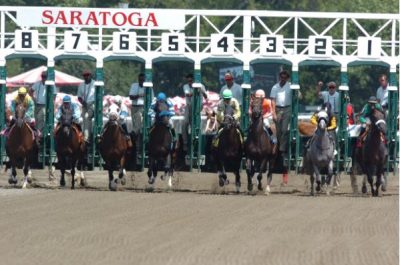by John Furgele
For the first time in several years, there is optimism at the New Jersey shore as Monmouth Park prepares for its opening day on May 4. As we know, New Jersey horse racing has struggled to keep up with neighboring states for a variety of reasons. Unlike Delaware, Pennsylvania and Maryland, New Jersey has lacked casino revenues to boost purses that both attract and keep horses on the grounds. When July comes, there is Saratoga to compete with and this year, the Spa opens eight days earlier than usual.
But things have changed. The governor is Phil Murphy and unlike his predecessor is a fan of horse racing. Let me rephrase: he may not be a fan, but he realizes the economic impact that horse racing has in New Jersey. It’s more than just nine or ten races on a Saturday afternoon. A Rutgers University study concluded that horse racing in the Garden State accounts for 13,000 jobs and $1 billion in economic impact. While taxpayers scoff at funding private industry, let’s ask the simple question—would you invest $100 million to generate $1 billion and have 13,000 workers paying taxes?
In January the New Jersey State Legislature passed a bill that allots $20 million per year to boost horses racing purses. The $20 million breaks down as follows–$10 million for Monmouth; $6 million for the Meadowlands; $1.6 million for Freehold and $2.4 million to support state breeding and New Jersey stakes programs.

Saratoga – Photo Courtesy of NYRA
That’s not the only reason for joy at Monmouth. New Jersey was one of the first states to offer sports betting; in fact, New Jersey was the state that sued to get that right and the William Hill Sports Book, located at the park, is flourishing.
Monmouth has gone from an afterthought to a summer player in no time at all. In 2019, the track will offer 61 racing dates, running from May 4 through Oct. 27. In addition, there will be seven days of thoroughbred turf racing at the Meadowlands and one day at Far Hills in October. Each racing day will offer at least $500,000 in purses. In May, they will race two days per week with a special Memorial Day card on May 27. In June, July and August that increases to three days a week with a special card scheduled for Thursday, July 4. There is also a Labor Day program on Monday, September 2.
News of the subsidy has caught the attention of horsemen. Trainer Chad Brown requested 65 stalls and Todd Pletcher will have a significant presence at the track this year. Maiden special weight races will run for $56,500 and there will be incentives for New Jersey bred horses that excel in open company. The Haskell Invitational, the track’s signature race will be run eight days earlier this year (July 20) and also moves from Sunday to Saturday.
The moving of the Haskell is not without controversy. NBC requested the move and had Monmouth balked, the race would have been broadcast on TVG, which reaches far fewer homes than the free over-the-air network. With the race just six weeks after the Belmont Stakes, some worry that trainers like Bob Baffert, Chad Brown and Todd Pletcher will hold their Triple Crown horses back because there is not enough time to rest, recover and prepare for another major stakes race. The Jim Dandy at Saratoga is on July 27 and even though it offers less money ($600,000) it does offer more rest after the Belmont.
On the positive, the Haskell-Travers double is friendlier with 42 days between races. The Haskell also retains its “win-and-you’re-in” status for the Breeder’s Cup Classic. The Saturday date should also increase attendance and handle. For most tracks, Saturday is the biggest handle day of the week and let’s be honest, a Saturday date gives revelers Sunday to sleep things off and be ready for the workweek.
While some worry about the date change, rest assured, the field for the $1 million Haskell will be a strong one. It may not attract an American Pharoah or a horse that ran well in all three Triple Crown races, but a free trip to the Breeder’s Cup Classic will lure many good horses to the New Jersey shore on July 20; it always has and always will.
This is a good problem, a good dilemma for the track. Last year, officials were concerned about the track’s long-term future. Would it survive and if it did, would it become a third rate track with $10,000 purses and fewer dates? Moving the Haskell may draw some ire from the purists, but it certainly is better than no Haskell, or one with lesser status.
In one year, look what has happened. A sports book sits on its grounds and there is $50 million in purse subsidies for the next five years to attract and retain horse racing talent; that’s a pretty good year before the starting gate even opens.
While many focus on Saratoga over the summer, Monmouth Park has always held its own and now seems poised to not only survive, but thrive going forward.

As a kid growing up in the Buffalo suburbs in the 1970s and 80s, the radio was one of John Furgele’s best friends. In the evenings, he used to listen to a show on WBEN radio called “Free Form Sports,” hosted by Buffalo broadcast legend Stan Barron. The show ran weeknights from 6 to 11 pm and featured every kind of sport you could imagine. One minute, Mr. Barron was interviewing a Buffalo Sabres player; the next, he was giving high school field hockey scores.
But there was always one thing that caught John’s ear. During those five hours, Barron would give the results from Western New York’s two harness racing tracks — Buffalo Raceway and Batavia Downs. This is where John learned what exactas, quinellas, trifectas and daily doubles were all about. From then on, he always paid attention to harness racing, and when Niatross (a legendary Western New York horse) hit the scene in 1979, his interest began to blossom.
John believes harness racing is a sport that has the potential to grow and he will explore ways to get that done via marketing, promotion and, above all, the races themselves.
When he’s not watching races, John is busy with his family and his job in sales. Like the pacers and trotters, he does a little running himself and you’ll occasionally find him “going to post” in a local 5K race.


